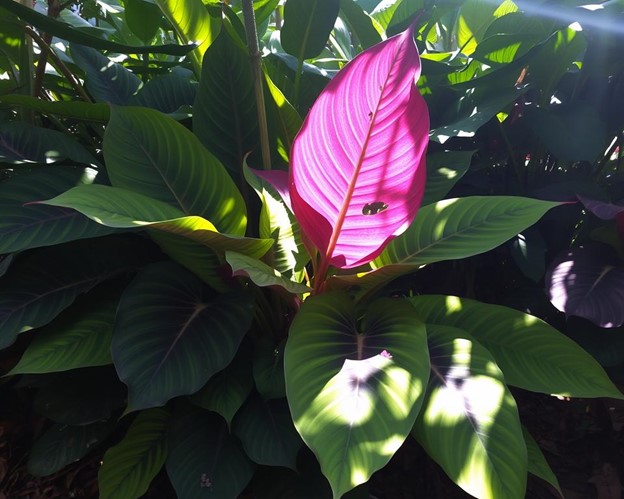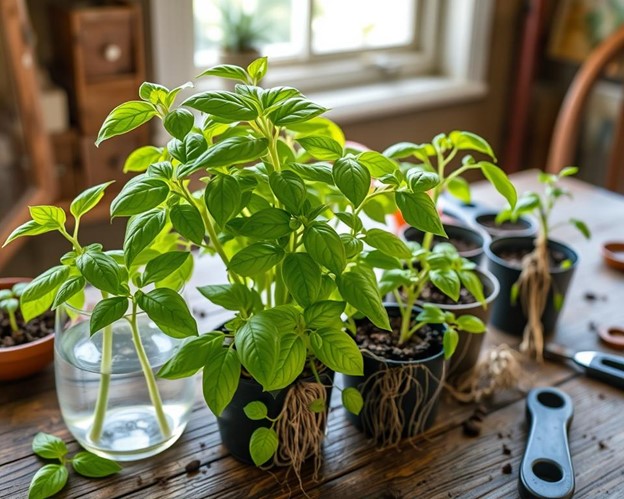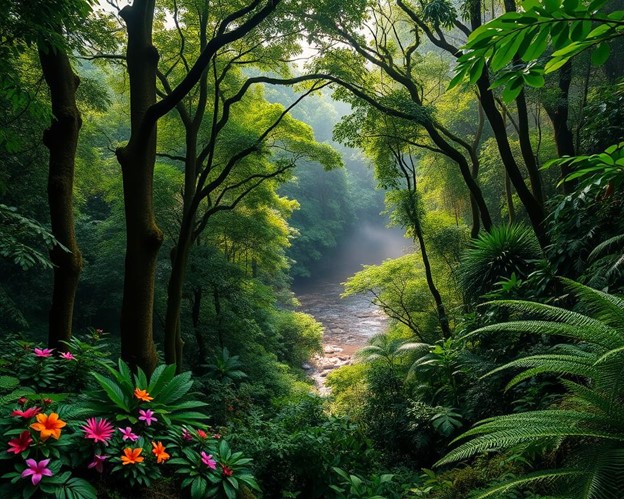Basil Fomanka: A Rare & Beautiful Houseplant

Ever heard of the Basil Fomanka? This tropical plant is a real treasure for indoor gardeners. Its striking leaves and exotic look make it a favorite among plant lovers. But why is it so sought after? Let’s dive into the fascinating story of this rare beauty.
Key Takeaways
- Basil Fomanka is a rare and highly sought-after tropical houseplant
- Its unique foliage and captivating appearance make it a standout among indoor plants
- Collectors and plant enthusiasts are drawn to its exotic charm and challenging cultivation requirements
- Proper care and attention are essential for this tropical gem to thrive indoors
- Understanding the Basil Fomanka’s origins, needs, and growth habits is key to successful indoor cultivation
What Makes Basil Fomanka Special Among Houseplants
Basil Fomanka is a rare and stunning tropical plant species. It has won the hearts of plant collectors all over the world. This unique houseplant comes from the lush, humid forests of Southeast Asia.
It has a remarkable natural history. It also has distinctive characteristics that make it stand out from other indoor plants.
Origins and Natural Habitat
Basil Fomanka belongs to the Lamiaceae family. It is native to tropical regions like Indonesia, Malaysia, and the Philippines. In its natural home, it thrives in the shaded understory of rainforests.
Here, it enjoys dappled sunlight and consistently moist, well-drained soil.
Unique Characteristics and Features
The Basil Fomanka is known for its striking, deeply-lobed leaves. These leaves can grow up to a foot long. They are lush, vibrant green with intricate patterns of veins.
The leaves have a velvety, almost iridescent texture. This gives the plant an enchanting appearance. Its compact growth habit and ability to tolerate various light conditions make it popular among tropical plant species enthusiasts.
Why Collectors Love This Plant
For many plant collectors, Basil Fomanka is a highly coveted rare houseplant and a true plant collector’s item. Its rarity in cultivation and exceptional visual appeal make it highly sought after. The challenge of recreating its native growing conditions adds to its allure.
The Basil Fomanka’s unique characteristics and ability to thrive indoors have made it a must-have for any avid plant enthusiast’s collection.
Essential Growing Conditions for Your Basil Fomanka
To grow the Basil Fomanka indoors, you need to focus on plant care and know its tropical plant requirements. This beautiful houseplant needs certain conditions to thrive indoors. Let’s look at what your Basil Fomanka needs to grow well at home.
Light Needs
Basil Fomanka loves bright, indirect light. Place it near a south- or west-facing window for the best light. Move it as the seasons change to match the light outside.
Watering Schedule
Keeping the soil moist is key for Basil Fomanka. Water when the top inch of soil feels dry. Don’t let the soil get too wet, as it can cause root rot.
Soil and Potting
Use a potting mix that drains well and is rich in nutrients. Mix peat moss, perlite, and compost for the best soil. Repot every 12-18 months to help the plant grow and prevent roots from getting bound.
Temperature and Humidity
Basil Fomanka likes warm, tropical-like conditions. Keep the temperature between 65-85°F. Also, keep the humidity between 50-70% to keep the leaves moist and promote growth.
By meeting your Basil Fomanka’s needs, you can enjoy its beauty indoors. Good plant care and indoor plant maintenance are crucial. With these, your tropical plant will thrive for many years.
Light Requirements and Placement Tips
The Basil Fomanka is a rare and beautiful houseplant. It needs the right amount of light to grow well and look vibrant. This plant needs a mix of indoor plant lighting and the right spot in your home.
Direct vs Indirect Light Needs
The Basil Fomanka loves natural light for plants. It does best in bright, indirect sunlight. Direct sunlight can burn its leaves. A south- or east-facing window is perfect for it, offering warm, filtered light.
Seasonal Light Adjustments
The Basil Fomanka’s light needs change with the seasons. In summer, it needs some afternoon shade to avoid leaf problems. In winter, when days are shorter, grow lights can help it get enough light.
Best Window Orientations
Choose the right window for your Basil Fomanka. East-facing windows are great, offering morning sun and afternoon shade. South-facing windows give consistent natural light for plants all day. West-facing windows need sheer curtains to protect from intense afternoon light.
Watering Schedule and Moisture Needs
Keeping the right watering schedule is key for your Basil Fomanka plant’s health. This houseplant needs consistent, careful watering and soil moisture checks.
The watering frequency for your Basil Fomanka depends on its size, the room temperature, and the soil’s drainage. Water when the top inch of soil feels dry. This usually means watering every 7-10 days in the growing season and less in winter.
Be careful not to overwater or underwater your Basil Fomanka. Overwatering can cause yellow leaves, wilting, and root rot. Underwatering leads to stunted growth, curled leaves, and stress. Watch your plant closely to find the right balance.
Use lukewarm, filtered water when you water your Basil Fomanka. Don’t let the plant sit in water, as it can harm the roots. Water until water drains from the pot, then wait until the soil dries a bit before watering again.
“Proper watering is the foundation for a thriving Basil Fomanka plant. With a little care and attention, you can ensure your plant stays lush, vibrant, and healthy for years to come.”
By following these watering tips and keeping the soil moist, you’ll create a great home for your Basil Fomanka. This way, you’ll avoid the dangers of overwatering or underwatering.
Soil Requirements and Potting Mix Guide
Choosing the right potting soil is key for your Basil Fomanka plant’s health. It needs a mix that drains well and is rich in nutrients. This mix should also help with soil aeration and root health. Let’s explore what your Basil Fomanka needs for the best growth.
Best Soil Components
The perfect potting mix for Basil Fomanka includes:
- High-quality potting soil or a general-purpose mix
- Compost or aged organic matter for nutrients
- Perlite or vermiculite for better soil aeration and drainage
- Coarse sand or pebbles to help with drainage and prevent soil compaction
Drainage Considerations
Basil Fomanka plants are prone to root rot. So, it’s crucial to ensure good soil drainage. Add lots of perlite, vermiculite, or coarse sand to the mix. This will make the soil drain well and keep the roots healthy. Avoid heavy, dense soils that can hold too much water.
Repotting Timeline
Basil Fomanka plants need to be repotted every 12-18 months. Or when their roots have outgrown the pot. Choose a pot that’s only slightly larger than the old one. This helps the plant thrive in a slightly root-bound environment.
When repotting, gently loosen the roots. Then, move the plant to the new pot filled with fresh, well-draining mix. Be careful not to harm the delicate roots.
Click On Read: – napipm 2018 event
Temperature and Humidity Management
Keeping the right temperature and humidity is key for your Basil Fomanka’s health. This rare tropical plant needs the right climate to thrive. It’s important to pay close attention to its needs.
The Basil Fomanka loves warm, humid places, like its natural home. To mimic this indoors, follow these tips:
- Keep the temperature between 65-85°F (18-29°C). Don’t let the plant face sudden or extreme temperatures.
- Use a humidifier or a pebble tray with water to increase humidity. You can also group it with other tropical plants.
- Make sure the plant has good air flow. This helps prevent stale air and keeps humidity steady.
- Check the humidity often and adjust it. Basil Fomanka does best in 50-70% humidity.
By keeping the right tropical plant care conditions, your Basil Fomanka will thrive. It will show off its beautiful leaves and unique traits.
| Temperature Range | Ideal Humidity Level |
| 65-85°F (18-29°C) | 50-70% |
Creating the right environment for your Basil Fomanka is crucial. It ensures the plant stays healthy and adds beauty to your home. By watching and adjusting temperature and humidity, you can make the perfect space for it to grow.
Pruning and Maintenance Tips
To keep your Basil Fomanka looking great, you need to prune it regularly and take good care of its leaves. By using the right methods, you can shape your plant, promote healthy growth, and keep it in top condition.
When to Prune
The best time to prune your Basil Fomanka is in the spring and summer. This is when the plant is growing the most. You can trim off dead, damaged, or too long growth, shaping it as you like. Don’t prune in the winter, as the plant is dormant then.
Tools and Techniques
To care for your Basil Fomanka, use clean, sharp pruning shears or scissors. These should be made for delicate plants. Cut just above a leaf node or branch, being careful not to harm the leaves or stems. Clean your tools before and after use to avoid spreading diseases.
When you prune, remove any dead, yellow, or discolored parts. You can also trim back long stems to keep the plant bushy. Always throw away the cut parts to stop pests or diseases from spreading.
| Pruning Tool | Recommended Use |
| Pruning Shears | For precise, clean cuts on stems and branches up to 1/2 inch in diameter |
| Scissors | For delicate trimming of leaves and small, soft growth |
| Bypass Pruners | For larger stems and branches, up to 3/4 inch in diameter |
By following these plant pruning and foliage care tips, your Basil Fomanka will thrive. It will be a beautiful addition to your indoor plants.
Common Problems and Solutions
The Basil Fomanka is a rare and beautiful houseplant that needs careful care to stay healthy and bright. It’s not too hard to take care of, but it can sometimes get pests or diseases. Knowing how to fix these problems will help your Basil Fomanka stay happy and healthy.
Fungal infections like powdery mildew or root rot can happen. These usually come from too much water or bad air flow. To stop and fix these problems, water your plant right and make sure it has good air flow.
- Avoid overwatering and ensure proper drainage
- Increase air circulation around the plant
- Prune affected leaves or stems promptly
- Apply a fungicide if necessary, following the instructions carefully
Plant pests like spider mites or aphids can also be a problem. Look for damage or color changes on leaves and stems. To fight pests, try misting the plant, introducing good bugs, or using a gentle soap.
| Common Plant Issues | Possible Causes | Solutions |
| Fungal Infections | Overwatering, Poor Drainage, Low Air Circulation | Adjust Watering, Improve Airflow, Apply Fungicide |
| Pest Infestations | Spider Mites, Aphids, Mealybugs | Regular Misting, Introduce Beneficial Insects, Use Insecticidal Soap |
| Leaf Discoloration | Improper Lighting, Nutrient Deficiency | Adjust Light Exposure, Fertilize Appropriately |
By watching for and fixing plant pests, plant diseases, and other troubleshooting plant issues quickly, your Basil Fomanka will stay a vibrant part of your indoor garden.
Propagation Methods and Success Rates
Basil Fomanka is a rare and stunning houseplant that’s easy to propagate. Whether you’re new to plants or have been growing them for years, learning how to multiply Basil Fomanka is fun. You can grow more of these plants using different methods.

Step-by-Step Propagation Guide
Stem cuttings are a popular way to propagate Basil Fomanka. Just cut a healthy stem below a leaf node and plant it in moist potting mix. Make sure the cutting is 4 inches long and remove lower leaves. Keep the soil moist but not too wet, and place it in bright, indirect light.
Leaf propagation is another great method. Take a healthy, mature leaf with some stem attached. Plant it in moist, well-draining potting mix in a tray or small container. Cover it with a clear plastic dome or bag to keep it humid. Place it in a warm, bright spot.
Best Time for Propagation
The best time to propagate Basil Fomanka is in spring and summer. This is when the plant is growing the most. It helps the cuttings or leaves grow roots and become new plants faster. Don’t propagate in cooler months, as success rates are lower.
| Propagation Method | Success Rate |
| Stem Cuttings | 80-90% |
| Leaf Propagation | 70-80% |
By following these steps and propagating at the right time, you can grow your own Basil Fomanka collection. It’s a rewarding process that lets you enjoy these rare and beautiful plants.
Companion Plants and Decorative Display Ideas
Basil Fomanka is a beautiful plant with captivating foliage and delicate blooms. It looks great with many indoor plants, making stunning arrangements. Try pairing it with Pothos or Philodendron for a graceful look. Or, add Monstera leaves for a tropical touch.
For a modern look, put Basil Fomanka in a simple white planter. This lets its unique features shine. Or, mix it with succulents or air plants for a unique indoor plant arrangement.
Basil Fomanka is perfect for tropical plant decor. Display it with other lush houseplants in woven baskets or rustic pots. Try different plant styling to show off its beauty and fit your home’s style.
FAQ
What is Basil Fomanka?
Basil Fomanka is a rare and beautiful tropical houseplant. It’s known for its striking foliage and unique features. Plant enthusiasts love it for its exotic look and collectible status.
Where does Basil Fomanka originate from?
Basil Fomanka comes from certain regions of Southeast Asia. It thrives in the tropical climate and natural habitats of this area.
What makes Basil Fomanka special among houseplants?
Basil Fomanka is rare and has distinctive characteristics. It has bold, vibrant colors and intricate leaf patterns. Its compact growth habit makes it a captivating addition to any indoor plant collection.
What are the essential growing conditions for Basil Fomanka?
Basil Foman ka needs specific conditions to thrive. It requires adequate light, consistent watering, and well-draining soil. It also needs the right temperature and humidity levels.
How much light does Basil Fomanka need?
Fomanka prefers bright, indirect light. It may need seasonal light adjustments or supplemental grow lights. This helps maintain its vibrant colors and optimal growth.
How often should I water Basil Fomanka?
Watering Fomanka is crucial. It needs consistent moisture but must have well-draining soil. This prevents overwatering and root rot.
What type of soil is best for Basil?
Basil thrives in well-draining, aerated potting mix. This mix should have the right balance of nutrients and drainage components. It supports its growth and overall health.
How do I maintain the ideal temperature and humidity for Basil Fomanka?
Basil prefers warm temperatures and high humidity. It may need humidifiers, pebble trays, or proper ventilation. These help create the optimal indoor growing conditions.
When and how should I prune Fomanka?
Pruning Fomanka is important. It helps maintain its shape and promotes healthy growth. Use the right tools and techniques to avoid damaging the plant.
How can I propagate Basil Fomanka?
Basil-Fomanka can be propagated through stem cuttings or leaf propagation. The best time for propagation is during the plant’s active growth season.
What are some good companion plants for Basil Fomanka?
Basil-Fomanka looks great with other tropical or foliage-focused houseplants. This creates a visually stunning and harmonious indoor plant arrangement.











K25LP Throttle Control: Easy Engine Speed Management
November 2, 2024[…] Basil Fomanka: A Rare & Beautiful […]
FISD Instructure: Online Learning Platform for Students
November 2, 2024[…] dashboard is your main hub. It shows your courses, assignments, and announcements. You can customize it to keep your studies […]